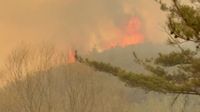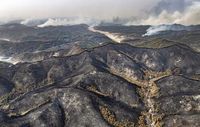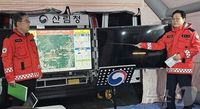The wildfires threatening South Korea have escalated into a serious crisis, with multiple incidents spanning the regions of Uiseong, Sancheong, and Hadong. The situation has become dire as the Uiseong wildfire has spread across a staggering 14,483 hectares, marking it as one of the most destructive in the nation’s history.
As of March 25, 2025, the Korean Forest Service reported a containment rate of approximately 60% for the Uiseong fire, while other fires in Sancheong and Hadong have also seen progress, with some areas reaching a containment rate of 90%. This progress, however, comes as strong winds and arid weather continue to plague efforts to fully extinguish the flames.
In an emergency meeting, Kwon Hyuk-dae, the acting head of the National Disaster and Safety Countermeasures Headquarters, emphasized the need for coordination among various government departments. He stated, “Wildfire suppression helicopters should focus on large wildfire areas while we maintain precautions in other regions,” pointing to the necessity of prioritizing resources in the most affected areas.
The fire situation intensified over the weekend, with officials warning residents of the potential risks. Several homes and farms have already tragically been lost, with reports indicating that around 60 structures succumbed to the flames, including residential properties and farms. As the disaster unfolded, many residents were evacuated to safety. At least 2,816 individuals have sought refuge across numerous shelters established in the wake of the fire, including schools and community centers.
Adding to the urgency, Gyeongnam Governor Park Wan-soo expressed concerns about the ongoing fire near Jirisan National Park, noting, “The wildfire is expected to be difficult to control due to the strong winds expected tonight.” His warnings reflect the challenges faced not only in Uiseong but throughout the area as impacts from looser winds are anticipated.
The ongoing firefighting operation faces hurdles that have complicated containment efforts. Difficult terrain, the availability of resources, and refined weather patterns have all impeded swift action against the flames. Many regions have reported fires flaring up due to unhealthy ambient conditions and volatile winds. As stated by the Korea Meteorological Administration, gusty winds reaching up to 15 meters per second are expected to continue disrupting firefighting operations.
In the aftermath, the wildfires have garnered widespread concern nationally, with local officials warning of increased risks due to climate change. Historically, wildfires in Korea have predominantly occurred during the spring months. Recent patterns, however, indicate this may longer be the case, as wildfires could extend into periods traditionally not associated with such events. Data suggests that incidences of wildfires have increased, fueled further by diminished moisture in the soil and vegetation over extended dry spells.
As storm forecasts provide a glimmer of hope, predictions suggest upcoming rainfall will likely be minimal, estimated at just 5 to 10mm, offering little in the way of significant relief from the ongoing threat of disaster. Authorities warn that even after the rainfall, substantial recovery and assurance measures will be paramount for impacted communities moving forward.
Evacuations remain ongoing as residents heed warnings. Public safety is the paramount concern for officials, and the government has vowed to deploy all available resources to better manage current firefighting efforts and establish preventative strategies for future incidents.
As officials continue to monitor the growing crisis, they face a twofold challenge of mitigating immediate dangers while also laying down groundwork for a comprehensive disaster response framework. With the cooperation of various agencies, the aim is to prevent the further loss of life and property, bringing the crisis under control while ensuring a safer environment for affected communities as recovery efforts begin.
Given the potential scale of this disaster and the rapid escalation of wildfires, the need for prepared emergency responses is clearer than ever. It is a sobering reminder of the impact of climate change, as disruptions in weather patterns and environmental conditions contribute to increasingly frequent and severe wildfire incidents across the country.








